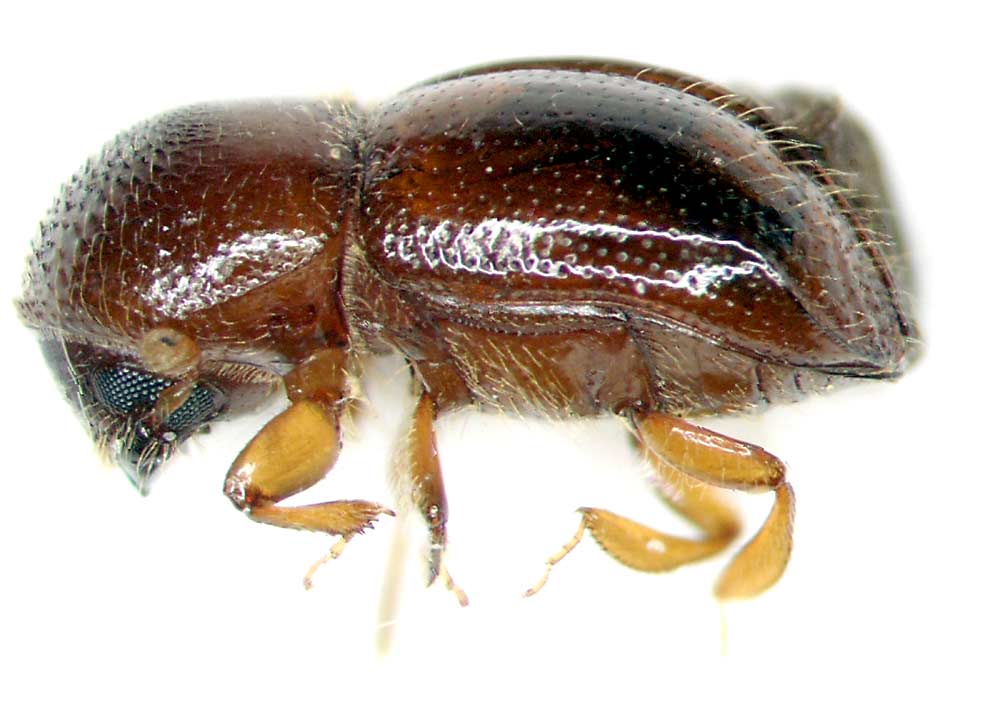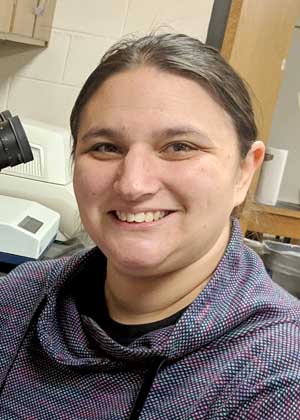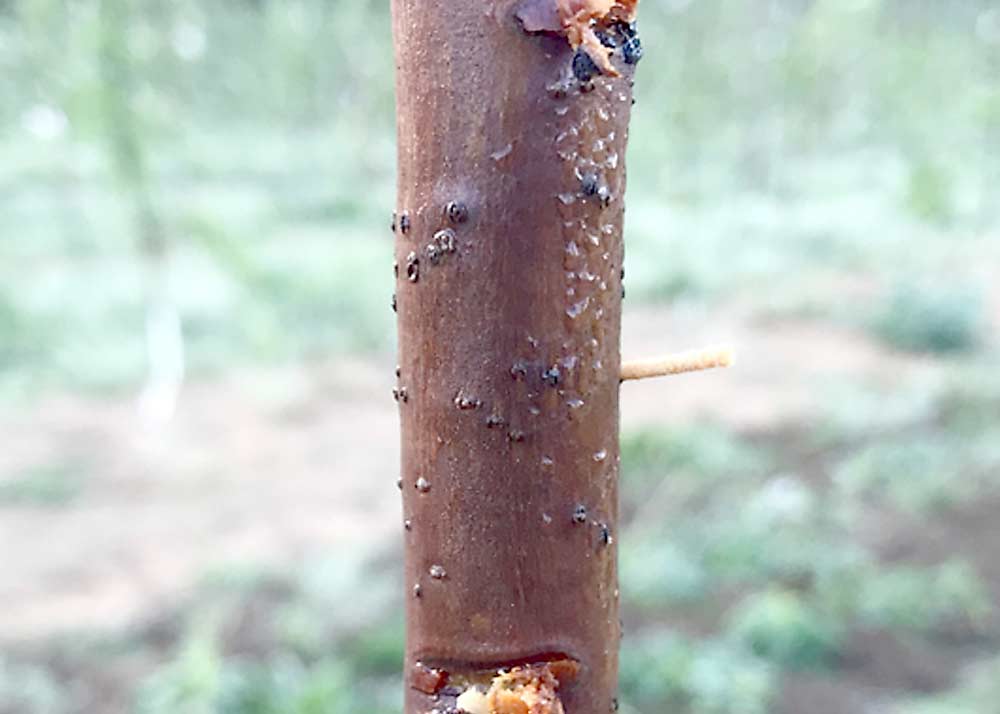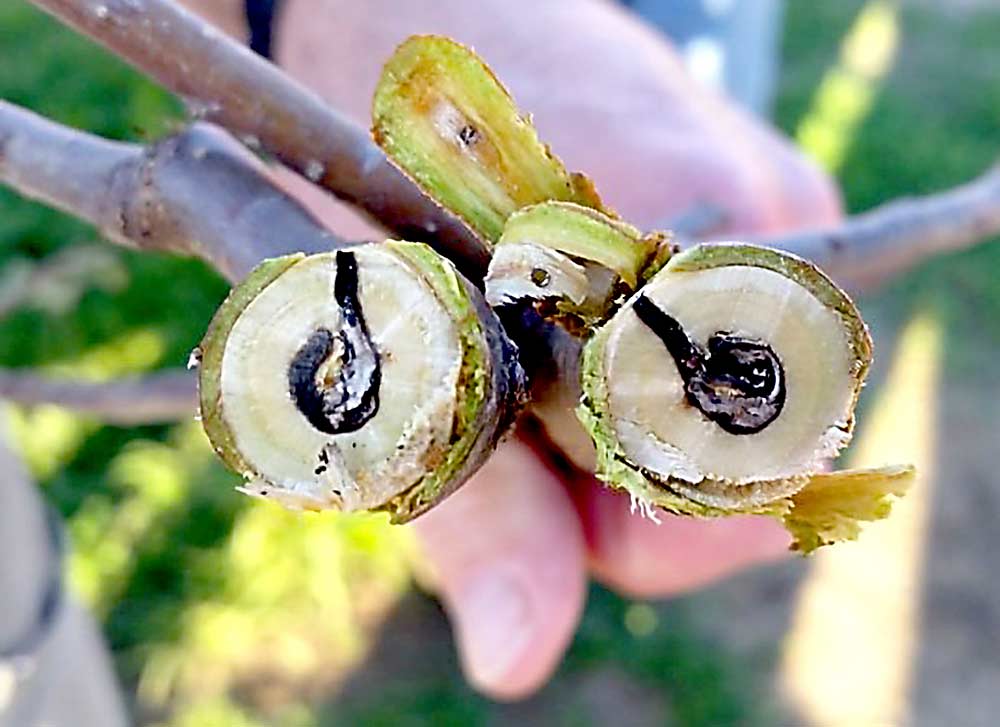
Measuring only about 2 mm long, the black stem borer is a type of weevil native to Eastern Asia. Sara Villani, apple pathology specialist at North Carolina State Extension, has found this weevil in trees experiencing rapid apple decline (RAD) and, with North Carolina State University entomologist Jim Walgenbach, is studying how it and related weevils may be connected to RAD. (Courtesy Pennsylvania Department of Conservation and Natural Resources)
Of the many outstanding questions surrounding the mysterious midseason collapse of young dwarf apple trees, now reported from New York to North Carolina, pathologist Sara Villani is particularly interested in the role played by wood-boring beetles.
In her work as a graduate student at Cornell University and now as a pathologist at North Carolina State University Extension, Villani has found black stem borers tunneling around the graft union, where the disorder’s characteristic decay seems to begin.
The beetles are attracted to the ethanol emitted by stressed trees, but Villani wanted to see if they were contributing to the decline as well, since pathologists suspect it may be caused by a confluence of tree stress factors. So, she designed a study to look at rapid apple decline (RAD) in North Carolina orchards and the role of ambrosia beetles, including black stem borers, which are invasive weevils native to Eastern Asia.
Beetle connection

Sara Villani
To determine how closely ambrosia beetles and RAD are linked, Villani’s research group, along with NCSU entomologist Jim Walgenbach, took a closer look at high-density orchards in North Carolina in 2017. This included counting the number of tunnel holes in trees at various stages of health.
They labeled trees “healthy” if they had no visually apparent symptoms, “early decline” if they had some chlorosis and slight wilt, “late decline” if they had reddish foliage but were still green within stems, and “dead” if the stems were brown inside. They also used ethanol traps to capture beetles in and on the edges of orchards.
The multipart research project showed:
—In a randomized sampling of 10 replications of 25 trees in an orchard block (250 trees), 8 to 35 percent of trees exhibited symptoms.
—Among five orchards studied, trees in poorer health had a greater number of beetle holes: 0.5 to two holes per healthy tree, three to eight holes per early-decline tree, four to 10 holes per late-decline tree, and eight to 11 holes per dead tree.
—Among seven orchards studied, a minimum of two flights/generations of ambrosia beetles occurred during the season. This included the black stem borer, as well as the tree fruit pinhole borer (Xyleborinus saxesenii) and the granulate ambrosia beetle (Xylosandrus crassiusculus).
As it turned out, 2017 was the worst year yet for RAD in North Carolina.
Researchers already knew that ambrosia beetles are attracted to the ethanol produced by stressed trees. Villani believes ambrosia beetle damage was high in 2017 because the trees were under stress from various factors.
One was drought. Although rainfall in 2017 was normal, the extreme drought hit the area hard in 2015 and 2016, and this was exacerbated by some growers’ decisions to provide inadequate, and in a few cases, no supplemental irrigation in either year, she said.
Daily temperature swings of up to 40 to 50 degrees Fahrenheit in December 2016 were another stressor, because they prevented the trees from fully acclimating before winter set in, she said.
“Most of the damage we saw (in 2017) was in that graft-union area where the tree tends to be the weakest anyway, and that’s the last part to harden off prior to winter,” she said.
Yet another stressor was the series of spring freezes that occurred in 2017. With this combination of drought, winter injury and spring freezes, she suspects the trees were pumping out lots of beetle-enticing ethanol.

When the female black stem borer burrows into the tree, the tunnels can sometimes be identified from a delicate, toothpick-like, sawdust-and-frass structure (seen here) extending from the hole. (Courtesy Tom Kon/NCSU)
One surprising finding from this research project was that beetles were sometimes found in healthy-appearing trees, which suggests the signs of stress aren’t readily apparent, Villani said.
“This shows us that we, as researchers, cannot necessarily accurately assess tree health visually, so we’re going to need more tools that can detect ethanol at the level that a beetle can,” she said.
Beat the borer
Although this work shows an association between ambrosia beetles and RAD, this does not necessarily mean the beetles cause RAD, Villani said.
Abiotic stressors, such as winter injury, are a likely precursor to RAD symptoms. Once a tree is weakened, viruses, opportunistic fungal pathogens and ambrosia beetles are believed to hasten tree decline.
(Researchers have uncovered a new virus associated with the mysterious decline, but proving it’s the culprit will require more research. For more on this, see Kate Prengaman’s article “Proving a pathogen” on Page 8 of the Feb. 15, 2019, issue of Good Fruit Grower or online here: goodfruit.com/viral-link-examined-in-rapid-apple-decline/)
Indeed, the beetles only arrive after the stressed trees start emitting ethanol. In fact, she conducted a small study in 2018 that identified the opportunistic fungal pathogens Botryosphaeria dothidea and Phomopsis at both the graft-union area and in the scion of most RAD trees.
But, again, whether those pathogens are a source of RAD or are just taking advantage of an already-stressed tree has yet to be determined.
Despite the questions still surrounding the origins of RAD, growers should be doing everything they can now to fight ambrosia beetle attacks. “And the most important thing you can do at this point is stress mitigation,” she said.

The female deposits and cultivates a symbiotic fungus within the tunnel (shown here in cross-section). She then lays her eggs and, when they hatch, the fungus serves as food for the growing larvae. (Courtesy Villani research program/NCSU)
Reducing drought stress should be at the top of the list.
“I’m talking about stress from lack of rainfall, but also from planting high-density systems without installing irrigation,” Villani said. “Think about it. We’re putting in trees with smaller root systems at 2.5 to 3 feet apart and with smaller row spacings, so there’s more competition for water, and likely competition for nutrients as well.”
Weekly spray applications will also control ambrosia beetles, she said. In 2018, Villani and Walgenbach conducted insecticide efficacy trials to determine the best insecticides to control ambrosia beetles in stressed trees.
They looked at soil-systemic insecticides; foliar applications of various neonicotinoids, pyrethroids and organophosphates; and PermaNet, which is a deltamethrin-impregnated netting wrapped around the trunk. They found no clear winner.
Cultural management is also important. “Avoid poorly drained and low-lying areas. Irrigate. Watch your fertilizer, so don’t fertilize too much as you’re approaching the fall. Take care with herbicide use, because mild damage may decrease cold hardiness,” she said.
Growers should also be careful with late-summer pruning, which can trigger the tree to start growing again and reduce cold hardiness, she added.
“And think about the rootstocks you’re choosing. For instance, the Geneva 935 — while it’s a bigger tree, it does have some cold tolerance,” she said.
Whether black stem borers and other ambrosia beetles are a cause of RAD or a consequence, she emphasized, they are an increasing danger and one that apple growers should heed. •
—by Leslie Mertz






Leave A Comment